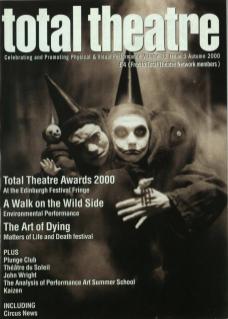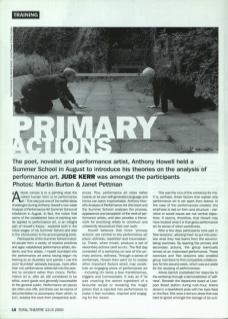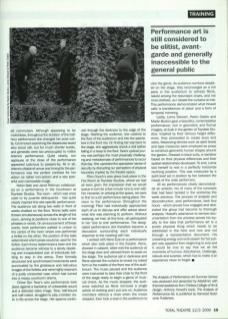‘A blank canvas is to a painting what the naked human form is to performance art.’ This was just one of the earlier ideas challenged during Anthony Howell's two-week Analysis of Performance Art Summer School at ArtsAdmin in August. In fact, the notion that some of the established laws of painting can be applied to performance art is an integral part of Howell's theory, explored both in the initial stages of his Summer School and also in the introduction to his accompanying book.
Participants of the Summer School included people from a variety of creative practices and ages: established performance artists, students and fine artists. I myself stumbled into the performance art arena having begun my training as an illustrator and painter. I use the word 'stumbled' advisedly because, more often than not, performance artists fall into the practice by accident rather than choice. Performance art is, after all, still considered to be elitist, avant-garde and generally inaccessible to the general public. Performance art pieces are often one-offs, and there can be reams of documentation to accompany them which, in turn, isolates the work from prospective audiences. Plus, performance art relies rather heavily on its own self-generated language and hence can seem impenetrable. Anthony Howell's Analysis of Performance Art (the book and the Summer School) analyses the process, appearance and perception of the work of performance artists, and also provides a framework for practising artists to construct and coherently deconstruct their own work.
Howell believes that three ‘primary actions’ are central to any performance art piece: stillness, repetition and inconsistency. These, when mixed, produce a set of secondary actions (and so on). The first day consisted of a workshop on one of the primary actions, stillness. Through a series of workshops, Howell then went on to isolate other important factors which may constitute an engaging piece of performance art – including (to name a few) transferences, triggers and homeostasis. It was as if he was unveiling the secret ingredient of a favourite recipe or revealing the magic potion that is injected into performance to make it feel rounded, inspired and engaging for the viewer.
This was the crux of the workshop for me. It is, perhaps, these factors that explain why performance art is set apart from drama. In the case of the performances created, the emphasis is laid on form and structure – narrative or social issues are not central objectives. It seems, therefore, that Howell may have located what it is that gives performance art its sense of other worldliness.
After a few days participants took part in ‘free sessions', allowing them to put into practice what they had learnt from the accumulating exercises. By layering the primary and secondary actions, the group eventually arrived at an improvised performance. These exercises and free sessions also enabled group members to find compatible collaborators for the second week, which was put aside for the devising of performances.
Arlene Garrett crystallised her response to the workshop through a demonstration of ‘stillness'. Beneath the departures board at Liverpool Street station during rush-hour, Arlene stood in a bewildered pose with her eyes fixed on the floor. She wore a red sun-dress that was hard to ignore amongst the barrage of be-suited commuters. Although appearing to be motionless, throughout the duration of the half-hour performance she changed her pose subtly. Commuters examining the departures board also stood still, but for much shorter bursts, and generally were too preoccupied to notice Arlene's performance. Quite clearly, our applause at the close of the performance appeared ludicrous to passers-by. All in all, Arlene's choice of venue and timing for the performance was the perfect contrast for her action (or rather non-action) and a very powerful and memorable image.
Robin Bale and Janet Pettman collaborated on a performance in the Courtroom at Toynbee Studios. The room – which was once used to try juvenile delinquents – had quite clearly inspired this site-specific performance. The audience sat along two walls in front of words chalked on the floor. Tennis balls were thrown simultaneously across the length of the room, arriving at positions close to one of the phrases or words. On announcement of these words, both performers walked in unison to the centre of the room where one performed a forfeit on the other. The position of the balls determined which props would be used for the forfeit. Each throw determined a loser and the audience became witness to a slowly depleting and incapacitated pair of individuals battling to stay in the arena. Their formally structured and synchronised movements were punctuated by the grotesque and ridiculous images of the forfeits and were highly resonant of a justly conducted case which had turned into a messy courtroom drama.
Chloe Dyn Tsoe's solo performance took place against a backdrop of unbearable sound and a distorted video image. Tsoe, half-bound and half-naked, struggled to play a broken violin in fits across the stage. Her spasms continued through the darkness to the edge of the stage. Startling the audience, she crashed to the floor of the auditorium and into the spectators in the front row. On finding her way back to the stage, she aggressively shook a doll before falling in a heap to the floor. Tsoe's cyclical journey was perhaps the most physically challenging and melodramatic of performances to occur that day. She uprooted the spectators' sense of security by disrupting our perception of physical boundary implied by the theatre space.
Ffion Couch's solo piece took place in the Fire Room at Toynbee Studios, where we had all been given the impression that we would queue in turn for a five-minute ‘one to one' with her. However, on arriving at the space, we were to find no such performance taking place. Previous to the performance (throughout the morning) Ffion had individually approached each of us to discuss and offer advice about what she was planning to perform. Without realising, we had, at this time, all participated in her ‘one to one' performance. The designated performance slot therefore became a discussion surrounding each individual's response to the meeting with her.
I worked with Rene Eyre on a performance which also took place in the theatre. Rene, dressed in cabaret attire, met the audience at the stage door and ushered them to seats on the stage. The audience sat in darkness and Rene opened the curtains to reveal my naked form in the middle of the front row of the auditorium. The music paused and the audience were instructed to take their chair to the front of the stage ready to begin a game of musical chairs. As the music stopped, the audience watched as Rene removed a single article of clothing and I put one on. Audience members without a chair when the music stopped, then took a seat in the auditorium to view the game. As audience numbers depleted on the stage, they reconverged as a full party in the auditorium to witness Rene, naked among the redundant chairs, and me (now clothed), as I closed the curtains on her. This performance demonstrated what Howell calls 'a transference of place’ and a form of temporal mirroring.
Lastly, Lorna Stewart, Pedro Diablo and Martin Burton gave a beautiful, contemplative performance, rich in geometric and formal imagery, at dusk in the garden at Toynbee Studios. Inspired by their obvious height difference, they proceeded to create duos and solos. Measuring devices such as spirit levels and tape measures were employed as props to construct geometric human shapes around the garden. Dressed in black suits, a narrative based on their physical differences and their spatial relationships developed. To end, Lorna laid herself to rest in a perfectly horizontal reclining position. This was measured by a spirit level set in position by her, between the heads of the male performers.
All six performances clearly demonstrated an eclectic mix of many of the concepts that had been tackled in the workshop the week previous. The process of analysis and deconstruction, post performance, took four hours – which proved how engaged and dedicated the group had become to thorough analysis. Howell's adamance to remove documentation from the process proves his loyalty to the idea that performance art is a purely physical thing which needs to be addressed in the here and now and not through a representative document. His unwaning energy and enthusiasm for his subject was apparent from beginning to end and it would be true to say that we all felt moments of humour, disturbance, challenge, ridicule and surprise, which has to make it an experience never to forget.
The Analysis of Performance Art Summer School was produced and presented by ArtsAdmin with financial assistance from Chelsea College of Art & Design. Anthony Howell's book, The Analysis of Performance Art, is published by Harwood Academic Publishers.


